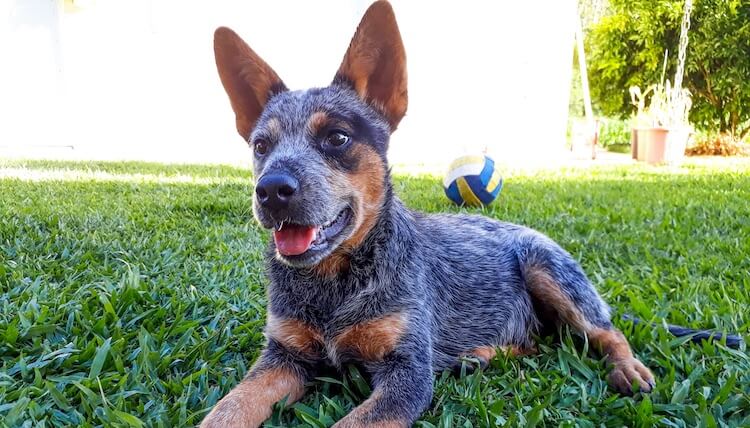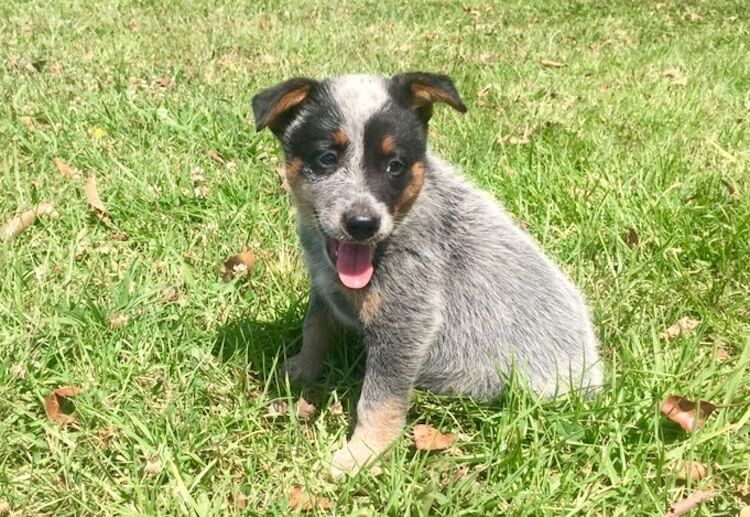
On a sunny afternoon in the park, I watched as a strikingly vibrant dog played fetch with unmatched enthusiasm. This wasn’t just any dog, but a Blue Heeler Lab Mix, a blend of spirited intelligence and warm loyalty. It dashed across the grass, its eyes gleaming with joy, a testament to the hybrid vigor that makes this mix so special. People often pause, struck by its unique appearance and vibrant energy, wondering about the kind of companion it makes.
Therefore, this article is your gateway to understanding the Blue Heeler Lab Mix. This crossbreed combines the best traits of the hardworking Australian Cattle Dog and the ever-friendly Labrador Retriever. You’ll discover why this energetic, affectionate companion might just be the perfect addition to your life, offering insights into their care, and temperament, and why they could be the ideal match for your active lifestyle.
TABLE OF CONTENTS
- Blue Heeler Lab Mix Quick Summary
- Blue Heeler Lab Mix Parent Breeds
- Blue Heeler Lab Mix Physical Characteristics
- Blue Heeler Lab Mix Personality and Temperament
- Heeler Lab Mix Care Guide
- Lab Heeler Mix Health Issues
- Blue Heeler Lab Mix Price
- FAQs on the Blue Heeler Lab Mix
- To Endless Adventures with a Loyal Pet!
- Other Labrador Retriever and Blue Heeler Mixes
Blue Heeler Lab Mix Quick Summary
Blue Heeler Lab Mix Parent Breeds
Before we talk about this unique mix, let me tell you a bit about the parent breeds.
Blue Heeler

From Adobe Stock

From Adobe Stock
Origin
The Blue Heeler, officially known as the Australian Cattle Dog, originated in Australia in the 19th Century. This breed was meticulously developed to herd cattle across the expansive and rugged Australian landscapes. By crossing native Dingoes with Collies and other herding breeds, a resilient and intelligent breed emerged, tailored for endurance and efficiency in cattle herding.
Physical Characteristics
Blue Heelers are medium-sized, robust, and muscular, reflecting their working breed status. I’ve noticed that they feature a unique coat, often in shades of blue, blue speckled, or blue mottled, which is both short and dense, designed to offer protection against various weather conditions. These dogs also have broad skulls, erect ears, and alert, expressive eyes, indicators of intelligence and vigilance.
Temperament and Behavior
The Blue Heelers I meet exhibit a deep commitment to their owners and the tasks at hand. The breed’s working background necessitates significant mental and physical engagement to prevent boredom and potentially destructive behavior. Naturally cautious around strangers, they serve as effective watchdogs, yet they show considerable affection and loyalty towards their families. I find that despite their high intelligence and trainability, their independent nature calls for consistent, patient training approaches.
Labrador Retriever
Origin
The Labrador Retriever, affectionately known as the Lab, has its origins in Newfoundland, Canada. Originally used by fishermen to haul nets and catch fish that escaped from fishing lines, Labs were bred for their strength, endurance, and excellent swimming abilities. In the 19th Century, they were brought to England, where they were refined and standardized by British breeders. This breed quickly gained popularity for its gentle disposition, intelligence, and versatility, eventually becoming one of the most beloved breeds worldwide.
Physical Characteristics
Labs are solidly built, medium to large dogs, known for their kindly eyes, otter tail, and weather-resistant coats, which come in black, yellow, and chocolate. Their broad heads and strong jaws were essential for their original job of retrieving game and fish, showcasing their heritage as efficient working dogs. Labs are athletic and energetic, requiring regular exercise to maintain their health and happiness.
Temperament and Behavior
I’ve always admired Labs for their friendly and outgoing nature. They are famously good-natured, making them excellent family pets and companions. Their intelligence and eagerness to please make them highly trainable, which is why they excel not just in homes but also as service and therapy dogs. Labs have an innate love for water and are always up for a game of fetch, reflecting their enduring work ethic and playful spirit. They are sociable animals, thriving in the company of humans and other dogs alike. Their adaptability and friendly demeanor make them suitable for various roles, embodying the essence of a loyal and dependable companion.
Blue Heeler Lab Mix Physical Characteristics

From Adobe Stock
Exploring the unique blend of traits in a Blue Heeler Lab Mix provides a fascinating glimpse into the world of hybrid vigor. These dogs are a testament to the best qualities of their parent breeds, the Australian Cattle Dog and the Labrador Retriever, yet they present with their own unique set of characteristics.
Height and Weight
A Blue Heeler Lab Mix typically falls into the medium-size category, but there’s quite a range when it comes to their weight and height. They can tip the scales anywhere between 35 to 80 pounds and stand 17 to 24.5 inches tall at the shoulder. This variance largely depends on which parent breed they take after more. In my observations, the more robust Labs contribute to the upper range of this scale, while the leaner Blue Heelers influence the lighter, more agile members of the mix.
Coat
When it comes to their coat, the Blue Heeler Lab Mix often sports the short, straight hair typical of both parent breeds. This makes them relatively low-maintenance on the grooming front. Their coats are designed for an active lifestyle, providing enough protection from the elements while not requiring the intensive care of longer-haired breeds. I’ve noticed that these mixes tend to inherit the dense, water-repellent coat of the Lab, combined with the hardy texture of the Blue Heeler, making them well-suited for outdoor adventures.
Color
The coat color of a Blue Heeler Lab Mix is where things get really interesting. They often exhibit a fascinating array of colors and patterns, including merle, brindle, spots, and patches. From the striking blue or red of the Heeler to the classic black, yellow, or chocolate of the Lab, and everything in between, these dogs are a canvas of their heritage. Each dog is uniquely patterned, and it’s not unusual to see a mix that looks almost like a patchwork quilt of dog genetics.
Shape
In terms of body shape, the Blue Heeler Lab Mix usually presents a long, lean silhouette indicative of both breeds’ athletic predispositions. Whether inheriting the Blue Heeler’s slightly more compact frame or the Lab’s robust build, these dogs are invariably sporty. Their ears might stand erect, echoing the alertness of the Heeler, or they may inherit the softer, drooping ears of the Lab, giving them a gentler expression. Their noses, typically black or brown, complement their versatile coat colors, rounding off their striking appearance.
Blue Heeler Lab Mix Personality and Temperament
I’ve found that the Blue Heeler Lab Mix is incredibly loyal and protective, traits that endear them to their families and make them excellent watchdogs. Their loyalty isn’t just about being protective; it’s also about forming deep, lasting bonds with their owners. They thrive on interaction and are always ready for a game or an adventure, which mirrors the energetic spirit of both parent breeds. Their playful nature makes them an ideal match for active individuals or families who embrace outdoor activities and plenty of playtime.
This mix is inherently social, enjoying the company of their human pack, yet they can be reserved or cautious around strangers. This duality in their temperament—a blend of the Lab’s friendliness and the Heeler’s watchfulness—makes them well-suited to households that appreciate a dog with a protective edge. They’re not just mindlessly barking at new arrivals; they’re assessing whether someone is a friend or a potential threat, always prioritizing the safety and well-being of their family.
Intelligent and Energetic
The intelligence of the Blue Heeler Lab Mix is something to behold. Drawing from the Lab’s renowned trainability and the Heeler’s sharp wit, they’re capable of learning a vast array of tricks and commands. This intelligence, however, means they require mental stimulation to prevent boredom. A bored Blue Heeler Lab Mix can be a handful, often resorting to barking or destructive behaviors if not properly engaged. This is why I always recommend enrichment activities, training, and regular exercise to keep their minds and bodies active.
The high prey drive, inherited from the Blue Heeler side, adds another layer of complexity to their personality. It’s not uncommon for these mixes to display herding behavior, sometimes even trying to herd children or other pets. This instinct can be channeled positively through activities like agility training or herding sports, where they can exercise both their bodies and their brains.
Guarding Tendencies
Their protective nature does mean that they are prone to barking, especially in response to unfamiliar people or animals encroaching on their territory. While this makes them excellent watchdogs, it can also be a challenge if not managed properly. Training and socialization from a young age can help mitigate excessive barking, teaching them when it’s appropriate to alert their family and when to remain calm.
Heeler Lab Mix Care Guide

From Adobe Stock
Taking care of a Blue Heeler Lab Mix is an adventure, full of moments that test your patience and reward your dedication in equal measure. From figuring out the right mix of physical exercise to keep them content, to the mental stimulation needed to satisfy their clever brains, every day is a new learning experience.
Feeding
Feeding a Blue Heeler Lab Mix is an important part of their overall care. These dogs are active and energetic, which means their diet needs to match their lifestyle. I’ve learned from talking to vets and other dog owners that getting their diet right can make a big difference in their health and happiness. Here, I’ll share some guidelines on how to feed this breed, focusing on what has worked well according to my research and conversations.
Choosing the Right Food
Finding the right food for a Blue Heeler Lab Mix involves looking at high-quality options that support their energy levels and health needs. I’ve seen that foods rich in proteins and fats, with minimal fillers like grains and artificial additives, are often recommended. These dogs do well on both commercial and home-prepared diets, as long as they meet the nutritional standards. It’s a good idea to talk to a vet to get recommendations based on the specific needs of your dog, considering their age, weight, and activity level.
Portion Sizes
Portion control is key for these mixes. Given their propensity for activity, it might seem like they can eat a lot, but overfeeding can lead to weight gain, especially if they inherit the Lab’s love for food. I’ve noticed that feeding guidelines on dog food packages are a good starting point, but it’s crucial to adjust based on your dog’s individual activity level. Regular check-ups with a vet can help monitor their weight and adjust food intake as necessary.
Feeding Schedule
Establishing a regular feeding schedule helps manage their energy and prevents overeating. From what I’ve gathered, two meals a day is a common recommendation for adult dogs, while puppies might require more frequent feedings. This not only aids in digestion but also helps in training and establishing a routine, contributing to their overall sense of security and well-being.
Treats and Supplements
While treats can be an effective training aid, it’s important to use them sparingly to avoid excess calorie intake. I’ve learned that choosing healthy treats and considering them as part of the daily food allowance is a good strategy.
Grooming Needs
Grooming a Blue Heeler Lab Mix is an essential part of their care that goes beyond just keeping them looking good; it’s about maintaining their health too. Let’s dive into some key aspects of grooming these energetic dogs.
Brushing
Regular brushing is crucial for a Blue Heeler Lab Mix, given their short to medium coat that can range from the Lab’s denser fur to the Heeler’s sleeker coat. I’ve found that brushing them a couple of times a week helps to reduce shedding and keeps their coat healthy. It also serves as a great way to check for any skin issues, ticks, or fleas. A grooming glove or a medium-bristle brush works well for their coat type, making the brushing session enjoyable for them and easier for you.
Bathing
Bathing a Blue Heeler Lab Mix doesn’t need to be a frequent task due to its relatively low-maintenance coat. Every few months is often enough unless they’ve rolled in mud or something smelly. Using a dog-specific shampoo that matches their skin type is important to avoid any irritation. I’ve learned that making bath time fun and stress-free from a young age helps them to be more cooperative as they grow.
Nail Trimming
Keeping their nails trimmed is another key aspect of grooming. Long nails can cause discomfort or even lead to problems with walking. Some dogs wear their nails down naturally through activity, but it’s good practice to check them regularly. If you can hear their nails clicking on the floor, it’s time for a trim. Many dog owners feel nervous about this part, so seeking advice from a vet or professional groomer can be helpful.
Ear and Teeth Care
Regular checks and cleaning of their ears can prevent infections, especially considering the potential for either erect or floppy ears in this mix. Using a vet-recommended ear cleaner and following proper techniques is essential. Dental care is equally important, with daily brushing being ideal to prevent tartar buildup and gum disease. Dental chews can also be a good addition to their oral hygiene routine.
Training and Exercise
Training a Blue Heeler Lab Mix is an engaging and rewarding process that requires a blend of consistency, patience, and understanding. I’ve put together some guidelines that can help navigate the training journey.
Starting training early is crucial for a Blue Heeler Lab Mix, given their sharp intellect and high energy. Positive reinforcement techniques work wonders with them, rewarding good behavior with treats, praise, or playtime. This breed mix thrives on structure and clear expectations, so establishing a routine and sticking to it is important. Because of their intelligence, they pick up on commands quickly but can also become bored with repetition, so keep sessions short and engaging.
Exercise
Exercise is not just a part of training for a Blue Heeler Lab Mix; it’s a necessity for their physical and mental health. They require a good amount of daily exercise—think long walks, jogs, or play sessions in a securely fenced area. These activities help manage their energy levels and prevent behavioral issues related to boredom or pent-up energy. Engaging them in activities like fetch, agility courses, or even dog sports can satisfy their need for physical activity while strengthening your bond.
Mental Needs
Meeting the mental needs of a Blue Heeler Lab Mix is as important as their physical exercise. They are incredibly smart, which means they need plenty of mental stimulation to stay happy. Puzzle toys, training sessions, and interactive games can keep their minds active. Teaching them new tricks or commands is not just a training exercise; it’s a way to keep their brain engaged and prevent boredom.
Socialization
Proper socialization is crucial for a Blue Heeler Lab Mix from an early age. This involves exposing them to a variety of people, environments, and other animals in a controlled and positive manner. Socialization helps them become well-adjusted adults who are comfortable in different situations. It can also temper their natural wariness around strangers and reduce the likelihood of aggressive behavior. Regular visits to dog parks, puppy classes, or simply walking in different neighborhoods can provide valuable socialization opportunities.
Lab Heeler Mix Health Issues
Taking care of a Blue Heeler Lab Mix means being aware of their health needs and potential issues. Here, I’ll cover some common health issues seen in Blue Heeler Lab Mixes, including what symptoms to watch for and the underlying causes.
Arthritis
Arthritis is a common condition in older dogs, including Blue Heeler Lab Mixes, characterized by the inflammation of joints, leading to pain and reduced mobility. Symptoms include limping, difficulty rising or lying down, reluctance to jump or climb stairs, and noticeable discomfort during or after exercise. The cause often stems from the wear and tear of the joints over time, though it can also be accelerated by injuries or obesity. Regular vet check-ups, maintaining a healthy weight, and providing joint supplements can help manage this condition.
Hip Dysplasia
Hip dysplasia is a genetic condition frequently seen in larger breeds but can also affect Blue Heeler Lab Mixes. It occurs when the hip joint doesn’t fit together perfectly, leading to pain, lameness, and arthritis. Symptoms can include difficulty standing up, reluctance to run or jump, and a noticeable limp. The condition is inherited, and while it can’t be prevented if a dog has the genes for it, maintaining a healthy weight and proper exercise can help reduce the severity of symptoms.
Patellar Luxation
Patellar luxation is when the kneecap (patella) dislocates from its normal position in the groove of the thigh bone. This condition can cause sudden lameness in the affected leg, with the dog often seen running on three legs before suddenly ‘kicking out’ the leg to pop the kneecap back into place. It’s caused by congenital abnormalities in the leg’s structure, though injury can also play a role. Treatment ranges from physical therapy to surgery, depending on the severity.
Progressive Retinal Atrophy (PRA)
Progressive Retinal Atrophy (PRA) is a group of genetic diseases that cause the photoreceptor cells in the eyes to degenerate over time, leading to blindness. Early signs include night blindness and dilated pupils that reflect more light than normal. Since PRA is genetic, there’s no cure, but affected dogs can live full lives with their owners’ understanding and adaptation to their blindness.
Blue Heeler Lab Mix Price

From Adobe Stock
Typically blue heeler Lab mix puppies are sold for $500 – $1,500. There are normally 5 to 8 puppies in each litter.
These puppies are very active, playful, and destructive. They will require lots of patience and training, especially if they inherit the stubbornness of blue heelers.
I find that most puppies are born with white fur (like their Dalmatian ancestors) and will change color as they mature. Because the Labraheeler is a mixed breed you should ask the breeder about their parents’ behavior and temperament.
When choosing a puppy make sure you see their mom. This is the best way to predict how big your puppy will grow and their appearance. Ask about the parents’ genetic history too. This hybrid is not a very common breed so you will need to search hard to find a reputable breeder.
FAQs on the Blue Heeler Lab Mix
How big does a Lab Heeler Mix get?
A Lab Heeler Mix typically grows to be a medium-sized dog, with adults weighing between 35 to 80 pounds and standing 17 to 24.5 inches tall at the shoulder. The exact size can vary, often depending on which parent breed the dog takes after more.
What are the exercise needs of a Heeler Lab Mix?
Heeler Lab Mixes are known for their high energy levels and require regular, vigorous exercise to stay healthy and happy. They thrive on activities such as long walks, runs, and play sessions in a secure area. Ideally, they should get at least an hour of exercise each day to satisfy their physical and mental needs.
What are the grooming requirements for a Lab Heeler Mix?
The grooming needs of a Lab Heeler Mix are relatively low compared to other breeds. Their coat, which can range from short to medium length, requires regular brushing a couple of times a week to remove loose hair and minimize shedding. Bathing can be done as needed, typically every few months, unless they get particularly dirty.
Are Heeler Lab mixes good with children?
Yes, Heeler Lab Mixes can be great with children, especially when raised with them from a young age. They are known for their loyalty and protective nature, as well as their playful and affectionate temperament. However, like with any dog, interactions between pets and young children should always be supervised.
Do Lab Heeler mixes have any common health issues?
Lab Heeler Mixes can inherit health issues common to their parent breeds, including hip dysplasia, patellar luxation, arthritis, and progressive retinal atrophy (PRA). Regular veterinary check-ups and a healthy lifestyle can help manage and potentially prevent some of these conditions.
How long do Heeler Lab mixes typically live?
The lifespan of a Heeler Lab Mix generally ranges between 12 to 15 years. Factors that can influence their lifespan include genetics, overall health, diet, and the level of care and exercise they receive throughout their life.
To Endless Adventures with a Loyal Pet!
Bringing a Blue Heeler Lab Mix into your life means you’re signing up for an adventure filled with energy, affection, and loyalty. From my observations and conversations with fellow dog enthusiasts, I can tell you that these dogs are not for the faint of heart. Their rowdy, high-energy nature requires an owner who’s not just willing but excited to dive into an active lifestyle alongside them.
Before deciding on adopting a Labraheeler, it’s crucial to ask yourself if you’re truly ready to match their zest for life. These dogs thrive with owners who cherish the outdoors and seek a companion for their adventures, whether it’s hiking, running, or simply exploring the great outdoors. They’re incredibly suited to life on a farm or any home where they can channel their energy and intelligence into meaningful activities.
For families considering a Labraheeler, it’s worth noting that these dogs do exceptionally well with older children who can engage in play and understand the needs of such an energetic breed.
Let us know what you think about this mix below.
Other Labrador Retriever and Blue Heeler Mixes
If you’re interested in learning about other Lab mixes or Blue Heeler mixes, check out the hybrid dog breeds below.
Lab Mixes
- German Shepherd Lab Mix
- Pit Bull Lab Mix
- Golden Retriever Lab Mix
- Rottweiler Lab Mix
- Beagle Lab Mix
- Border Collie Lab Mix
- Husky Lab Mix
- Australian Shepherd Lab Mix
- Labrabull
- Labradoodle dog
- Boxador
- Mini Labradoodle
- Australian Labradoodle




Be the first to comment